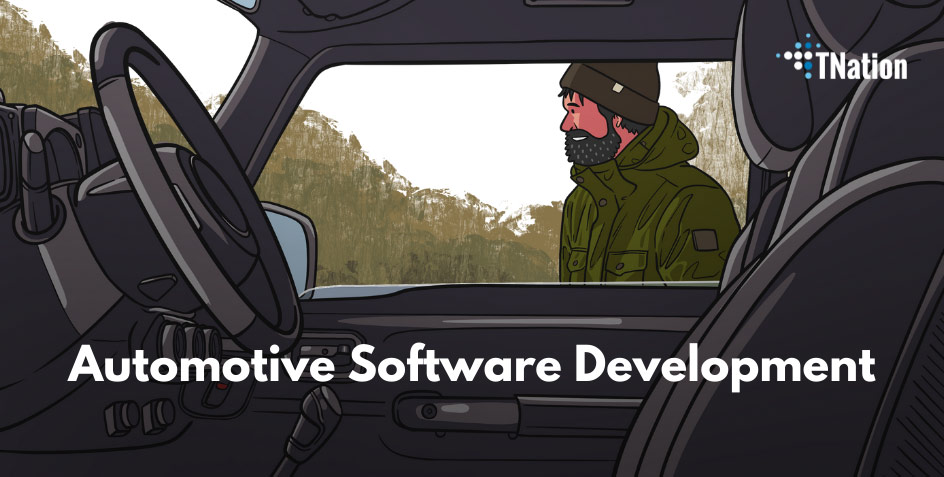TNation’s Senior Software Engineer talks about his working experience, power of code and team in the current automotive industry.
Modern-day cars have become increasingly complex in electronic systems. Analysis of Deloitte shows that technology comprises 40% of vehicle’s price. It means that humans drive around in a software-powered machine. Automotive software development helps car manufacturers switch to a faster gear and improve future performance.
Milan Simić is TNation’s senior software engineer leading the team with years of experience in automotive technologies and robust software. Working on long-term projects, he uses his automotive sector knowledge to understand clients’ needs better. During the two decades of software development, Simić has met with numerous clients.
“In my entire career, I have never come across a client with a plan for a software solution. But that’s pretty understandable. Most clients know their business but not the development process.” Milan is always there with team members to provide ideas for application and give the client insight into the upcoming development process.
“Automotive software development process and its execution must always be transparent to the client. It doesn’t matter if the client’s background is technological or not. The task of the team or its specific members is to keep the client in a closed-loop,” explains Milan.
As he describes, frequent contact with the client keeps the project within the limits of reality. Often, clients come with different professional backgrounds. Therefore, every input is valuable for the automotive software development team, keeping them involved with the client’s vision. In addition, accurate information has a significant impact on the successful outcome of the project.
Technology is not the Most Important Thing in Automotive Software Development Take it from the Tech Guy
“I always say that nothing ever starts from scratch. If nothing else, the client understands his business needs and has a solid idea of where he wants to go with the future solution. This concept is what the development team inherits.” – Milan Simić.
Milan has led teams for years, and during his experience, there are two kinds of projects. The ones that are already in progress where the team inherits pre-existing artefacts and brand-new projects.
Regardless of the situation, Milan explains that establishing mutual understanding between the client and the team is more important than technology in use.
“Although I have been a “technology guy” ever since I remember, I must say it is not the most important factor to start with. What’s more, forcing technology right at the beginning can be a bad choice,” said Milan.
Understanding the requirements is much more vital, according to him. Automotive software is complex, but it is not uncommon for the criteria to be equally intricate. Deducing the project needs such as vision, ideas, terminology, and documentation is a detailed process that builds exceptional software.
Milan relates that stakeholders often have trouble conveying their requirements and expectations. Hence, the qualified engineer can promptly investigate the needs of the specific business further.
There are often situations in the automotive software development industry when teams inherit software artefacts. However, Milan explains the reluctance among many software development services worldwide to accept such a challenge.
Their hesitancy to embark on such projects rests on differences among teams. Solutions and logic may differ from one another. Frequently, there is frustration on unclear or complete lack of documentation.
But, as stated by Milan, these are the stages that can only help the team understand where the client’s current position. That is also a good indication of what the client expects from improvement.

Driving in the Lane of Automotive Sector
Milan has been working in the US for years, and engaging with global companies is no different from Europe. The only difference he sees is in the structure of the project and team.
“If I could choose one different thing, it would be a more pronounced structure of project execution and teams. The team organisation is directly related to the project budget, and US companies can afford such arrangements because their resources are higher than in Serbia.”
Automotive industry software does not depend on geographical location, however. Software in the car industry is similar to other industries that use production management or automation, such as robotics. Consistent with Milan’s words, the crucial characteristics of automotive software development are coherency and reliability.
They largely depend on the team developing assigned software. As a team lead, Milan believes that the great team is the one that produces solutions instead of merely fulfilling the requirements. He describes that the excellent team reveals itself after briefing the story, direction, and crucial points.
In TNation, he found such a capable team participating in the discussion on the topic:
“I absolutely could not have foreseen this. That shows two things. One, the team has grown and quickly understands expectations.
The second and more important is that the team has the power to evolve implementation. Team members can see other circumstances during development that could potentially affect the task. These situations are not defined by agreement criteria or underlined in the briefing.”
Milan states that this type of team builds high-quality deliverables and adds that it needs considerable work to achieve such professionalism. In other words, groups such as these can improve existing systems and get the most for the businesses through automotive software development services.
The automotive industry is a dynamic ecosystem with rapidly evolving consumer preferences. Therefore, high-quality products depend on a strategic approach, a sharp focus on operational efficiency, and the software development team’s experience.
WHY TNATION FOR AUTOMOTIVE SOFTWARE DEVELOPMENT
TNation teams offer dedicated software development for automotive companies and assist in building their projects that result in business growth.


